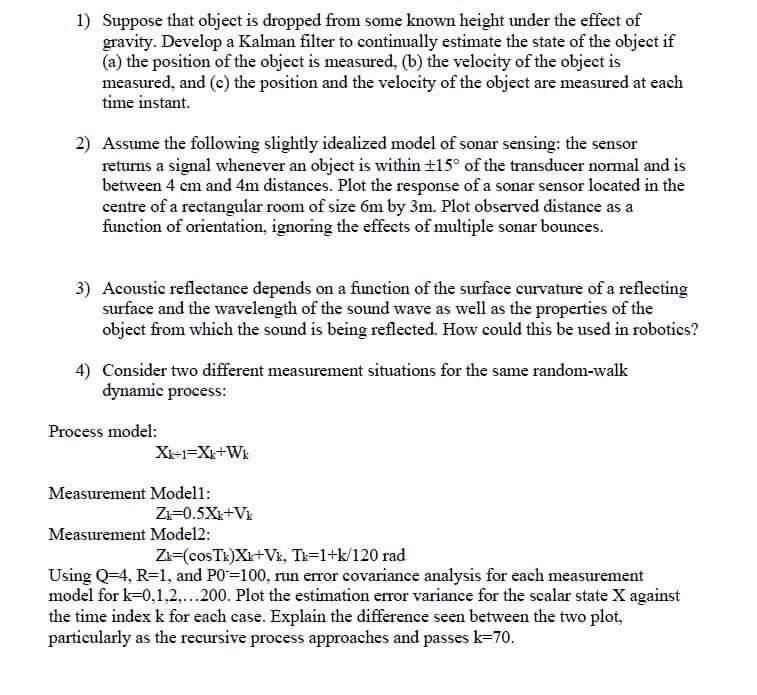
1) Suppose that object is dropped from some known height under the effect of gravity. Develop a Kalman filter to continually estimate the state of the object if (a) the position of the object is measured, (b) the velocity of the object is measured, and (c) the position and the velocity of the object are measured at each time instant. 2) Assume the following slightly idealized model of sonar sensing: the sensor returns a signal whenever an object is within +15 of the transducer normal and is between 4 cm and 4m distances. Plot the response of a sonar sensor located in the centre of a rectangular room of size 6m by 3m. Plot observed distance as a function of orientation, ignoring the effects of multiple sonar bounces. 3) Acoustic reflectance depends on a function of the surface curvature of a reflecting surface and the wavelength of the sound wave as well as the properties of the object from which the sound is being reflected. How could this be used in robotics? 4) Consider two different measurement situations for the same random-walk dynamic process: Process model: XI-1=Xk+WX Measurement Modell: Z=0.5Xx+VE &+V1 Measurement Model2: Zx=(cosTk)Xi+Vk, T1=1+k/120 rad Using (=4, R=1, and Po=100. run error covariance analysis for each measurement model for k=0,1.2....200. Plot the estimation error variance for the scalar state X against the time index k for each case. Explain the difference seen between the two plot, particularly as the recursive process approaches and passes k=70. 1) Suppose that object is dropped from some known height under the effect of gravity. Develop a Kalman filter to continually estimate the state of the object if (a) the position of the object is measured, (b) the velocity of the object is measured, and (c) the position and the velocity of the object are measured at each time instant. 2) Assume the following slightly idealized model of sonar sensing: the sensor returns a signal whenever an object is within +15 of the transducer normal and is between 4 cm and 4m distances. Plot the response of a sonar sensor located in the centre of a rectangular room of size 6m by 3m. Plot observed distance as a function of orientation, ignoring the effects of multiple sonar bounces. 3) Acoustic reflectance depends on a function of the surface curvature of a reflecting surface and the wavelength of the sound wave as well as the properties of the object from which the sound is being reflected. How could this be used in robotics? 4) Consider two different measurement situations for the same random-walk dynamic process: Process model: XI-1=Xk+WX Measurement Modell: Z=0.5Xx+VE &+V1 Measurement Model2: Zx=(cosTk)Xi+Vk, T1=1+k/120 rad Using (=4, R=1, and Po=100. run error covariance analysis for each measurement model for k=0,1.2....200. Plot the estimation error variance for the scalar state X against the time index k for each case. Explain the difference seen between the two plot, particularly as the recursive process approaches and passes k=70







